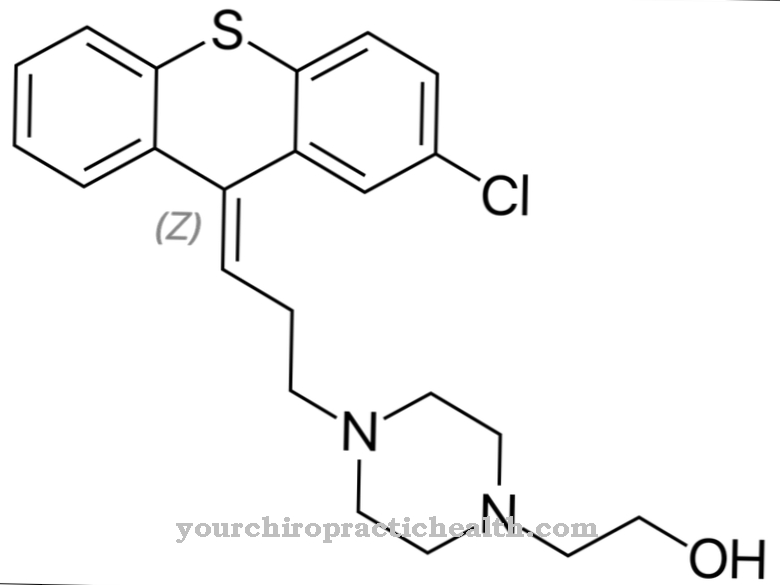Etoricoxib As a COX-2 inhibitor, it belongs to the group of non-steroidal anti-inflammatory drugs (NSAIDs). The active ingredient, which is used in particular as an anti-inflammatory and pain reliever, is said to be gentler on the stomach and bowel than traditional non-steroidal anti-inflammatory drugs.
What is etoricoxib?

Etoricoxib (Molecular formula: C18H15ClN2O2S) is a drug from the active ingredient group of coxibs or COX-2 inhibitors, which, through their targeted inhibition of the enzyme cyclooxygenase 2 (COX-2), have a pain-relieving and anti-inflammatory effect.
COX-2 inhibitors belong to the non-steroidal anti-inflammatory drugs NSAID (non-steroidal anti-inflammatory drug). The active ingredient is a dipyridyl derivative that has a phenylsulfonamide that interacts with the binding pocket of the COX-2.
The substance is mainly used in the context of symptomatic therapy of swellings and pain that occur in the case of degenerative (due to wear and tear) and / or inflammatory-rheumatic joint diseases. Etoricoxib is usually administered in tablet form.
Pharmacological effect
The active substance Etoricoxib is used in particular because of its anti-inflammatory and analgesic characteristics. This effect is comparatively prompt (on average after 25 minutes) through the selective, i.e. Inhibition of cyclooxygenase 2, which affects only one subform.
Cyclooxygenase 2 is an important enzyme in the biosynthesis of prostaglandins, which trigger fever as well as inflammatory processes and pain symptoms in the organism. Etoricoxib also inhibits thromboxanes, which are involved in the synthesis of prostaglandins, and prostacyclins (sub-forms of prostaglandins that promote inflammation). Since etoricoxib does not inhibit COX-1 (cyclooxygenase 1) or prostaglandin synthesis in the stomach or impair the function of the blood platelets, its inhibitory effect, as with all coxibs, is very targeted and selective.
It is assumed that due to the lack of inhibition of the sister enzyme COX-1, which participates in the biosynthesis of the prostaglandins in the stomach that protect the mucous membrane, etoricoxib therapy leads to less pronounced impairment of the gastrointestinal tract (gastrointestinal tract) and less Manifestations of ulcer and bleeding than conventional nonsteroidal anti-inflammatory drugs leads to. However, by inhibiting COX-2, etoricoxib can mask fever and other signs of inflammatory or infectious disease.
Medical application & use
Etoricoxib is mainly used for the therapy of pain and inflammation symptoms that occur in the context of inflammatory rheumatic joint diseases such as osteoarthritis, active gout attacks (acute joint inflammation) and rheumatoid arthritis.
In addition, therapy with etoricoxib may be indicated for chronic movement pain, primary menstrual cramps, postoperative toothache or ankylosing spondylitis (ankylosing spondylitis). Due to the long half-life (about 22 hours) of etoricoxib, a single application per day is usually sufficient, which is usually administered orally in the form of tablets (30, 60, 90 or 120 mg).
Since the risk of cardiovascular events such as myocardial infarction increases with increasing treatment duration and / or dosage, the risk-benefit ratio should be carefully considered when treating with etoricoxib and, if necessary, the shortest possible therapy and the lowest possible dosage should be selected. In addition, regular checks on the success of the therapy and potential side effects are indicated, especially for those affected by osteoarthritis and in the case of pathologically changed liver function values.
If symptoms of liver dysfunction and / or persistently elevated liver values are present, etoricoxib therapy should be discontinued.The active ingredient should also be discontinued if there are first signs of impaired mucous membranes, skin rashes and / or other hypersensitivity reactions.
You can find your medication here
➔ Medicines for painRisks & side effects
The taking of Etoricoxib is associated with a number of undesirable side effects and interactions. For example, long-term, high-dose application of the active ingredient can increase the risk of cardiovascular events.
Dizziness and headaches, edema, high blood pressure, palpitations, digestive and gastrointestinal complaints, fatigue, skin bleeding, nausea, an increase in liver enzymes and flu-like illnesses are described as undesirable side effects. Therapy with etoricoxib is also particularly important in the presence of pregnancy, hypersensitivity to the active ingredient, active intestinal and / or gastric ulcers, inflammatory diseases of the intestine, gastrointestinal bleeding, pronounced liver dysfunction, kidney or moderate to severe heart failure and contraindicated in coronary artery disease.
In addition, etoricoxib therapy in combination with warfarin can lead to a prolonged blood clotting time, while parallel treatment with acetylsalicylic acid can cause gastric ulcers and other complications. Concomitant use of etoricoxib with tacrolimus and ciclosporin can lead to an increase in the toxic effects of the two immunosuppressants on the kidneys.
Therapy with simultaneous intake of ketoconazole (antimycotic), rifampicin (antibiotic) and orally administered salbutamol and minoxidil (antihypertensive) should also be carefully considered in terms of the risk-benefit ratio. Further interactions of etoricoxib are observed in the context of simultaneous treatment with ACE inhibitors, diuretics, lithium, sartans, oestrogens, methotrexate, digoxin and prednisone.













.jpg)

.jpg)
.jpg)











.jpg)